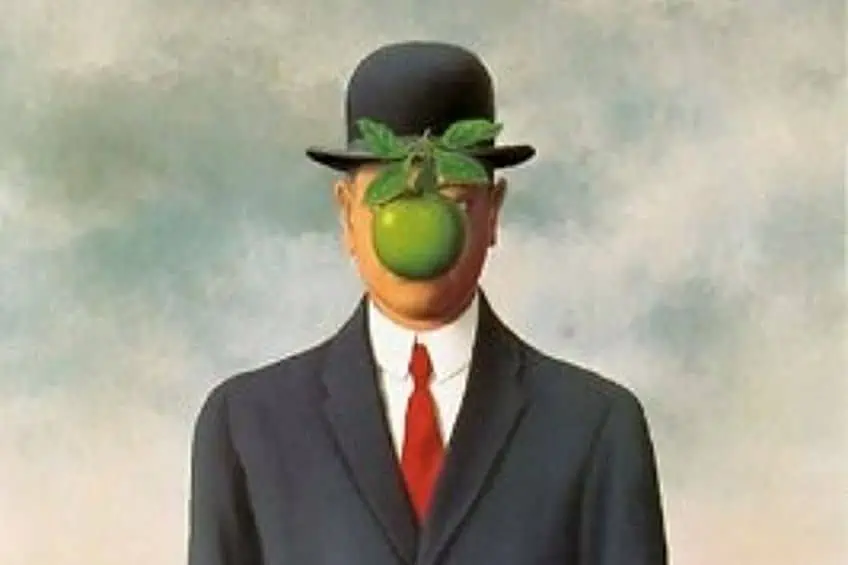“The Son of Man” by René Magritte – A Detailed Analysis
Everyone at one time or another has gazed upon the famous apple painting and wondered what exactly it means. But, who painted the famous Surrealism artwork and who is the son of man mentioned in the painting’s title? The Son of Man painting is a René Magritte artwork and was produced in 1964 (or possibly 1946). Let’s find out more about The Son of Man by René Magritte so that we can uncover The Son of Man’s meaning and influence.
Contents
Discovering the Meaning of The Son of Man by René Magritte
| Artist Name | René Magritte (1898 – 1967) |
| Date of Completion | 1946 (or possibly 1964) |
| Medium | Oil on canvas |
| Dimensions (cm) | 116 x 89 |
| Current Location | Private collection |
René Magritte’s artworks are renowned the world over, but this famous Surrealism artwork is perhaps his most well-known. But, who is the son of man in the picture? This famous apple painting was apparently originally meant to be a self-portrait of the artist. In The Son of Man painting, we can see a well-dressed gentleman, wearing a coat over a white shirt with a red tie. He is also wearing a bowler hat and most of his facial features are hidden behind a large green apple.
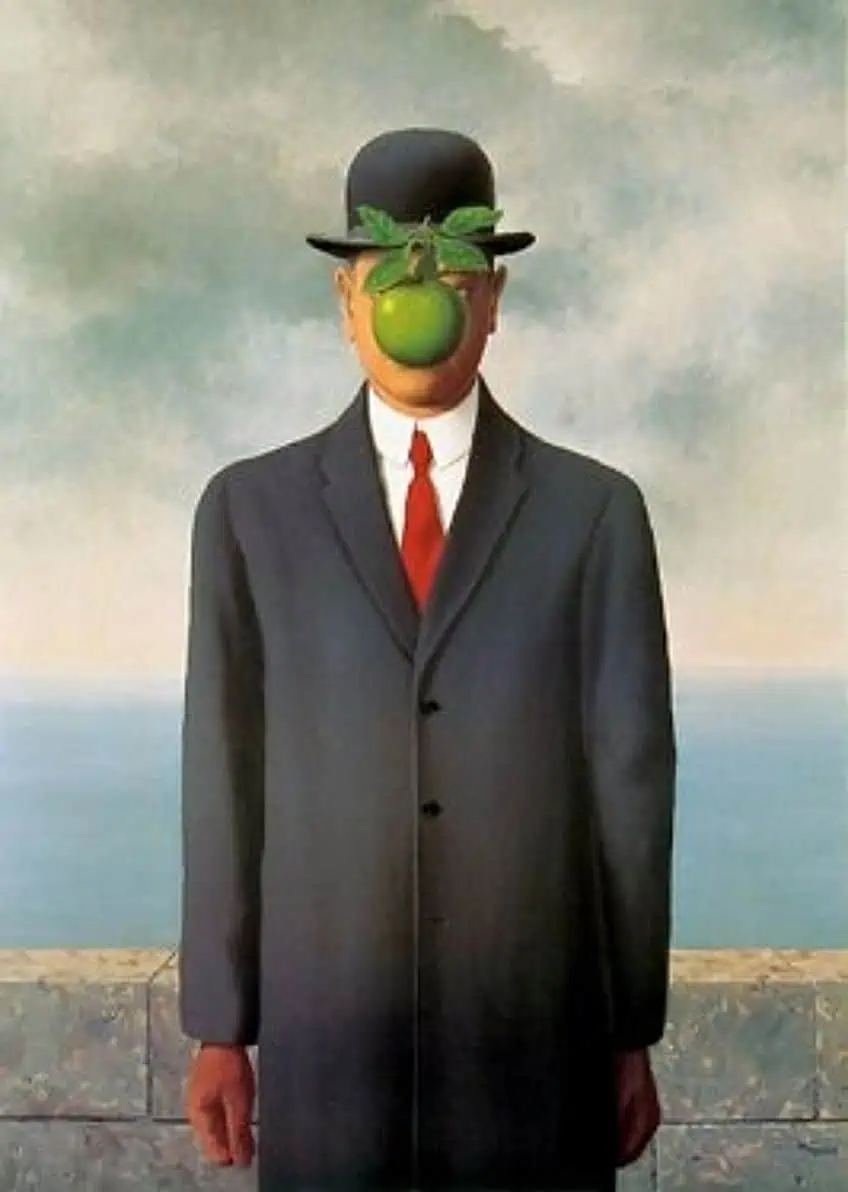
Behind the gentleman, we can see a low wall and a seascape beneath a cloudy gray sky. One subtle aspect of the picture that is hard to ignore once you have spotted it, is that the subject’s left arm is bending the wrong way at the elbow! If you look close enough, you will also notice that the subject is peeking to us from behind the apple, his eyes just barely visible to us. Some argue that the painting is meant to be ambiguous so that the viewer can draw their own conclusions as to what it all means.
But did the artist have his own interpretation of The Son of Man meaning?
The Story Behind The Son of Man Painting
What led up to the painting of this famous Surrealism artwork? Were René Magritte’s artworks always produced in this style? Before we find out more about The Son of Man’s meaning, let’s first learn a bit about the artist himself.
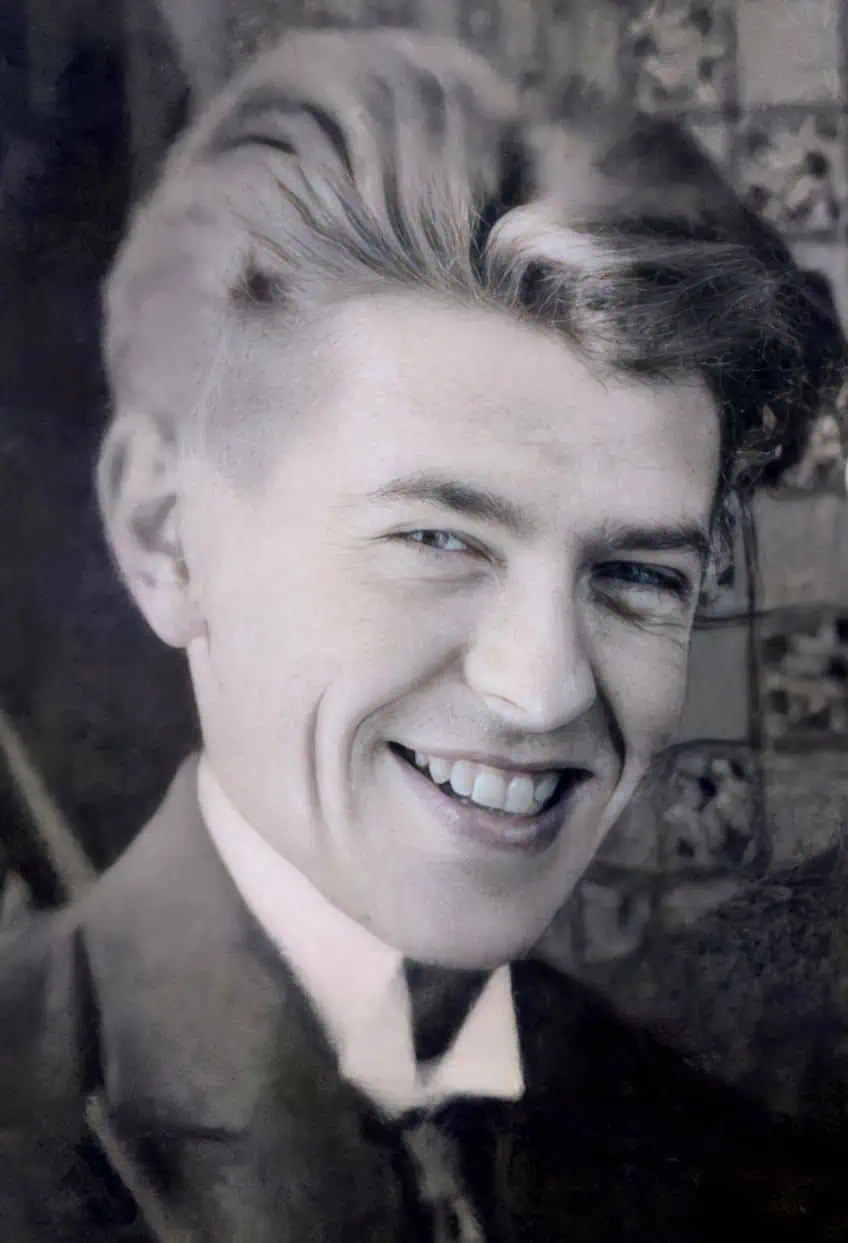
The Man Behind the Artwork – René Magritte
Despite starting his creative career with Impressionist artworks, Magritte really excelled at producing humorous and thought-provoking pieces in a Surrealist art manner. He first started experimenting with Surrealism while employed as a wallpaper factory draftsman, creating his very first Surrealist piece The Lost Jockey (1926). This artwork depicts a jockey riding on horseback through what seems to be a staged setting, with wooden planks showing beneath the horse’s feet and curtains on either side of the stage. His debut solo exhibit was held in 1927 but was left devastated when art reviewers snubbed his paintings.
The reaction of the critics to his exhibit motivated his decision to relocate to Paris, where Magritte encountered other renowned Surrealist artists such as Joan Miro, Salvador Dalí, and Max Ernst.
While Paris motivated him to finish paintings such as The Treachery of Images (1929) and The Lovers (1928), the artist failed to leave a permanent impression on the Parisian art scene, and in 1930, he returned to Brussels. The start of World War II prompted his Renoir era, during which he adopted a colorfully vibrant style in response to the destruction and chaos of wartime. He added that the Nazis were far more effective than Surrealism in creating a mood of disorder and chaos, therefore, he suggested a new search for happiness and pleasure in the face of pervasive despair.
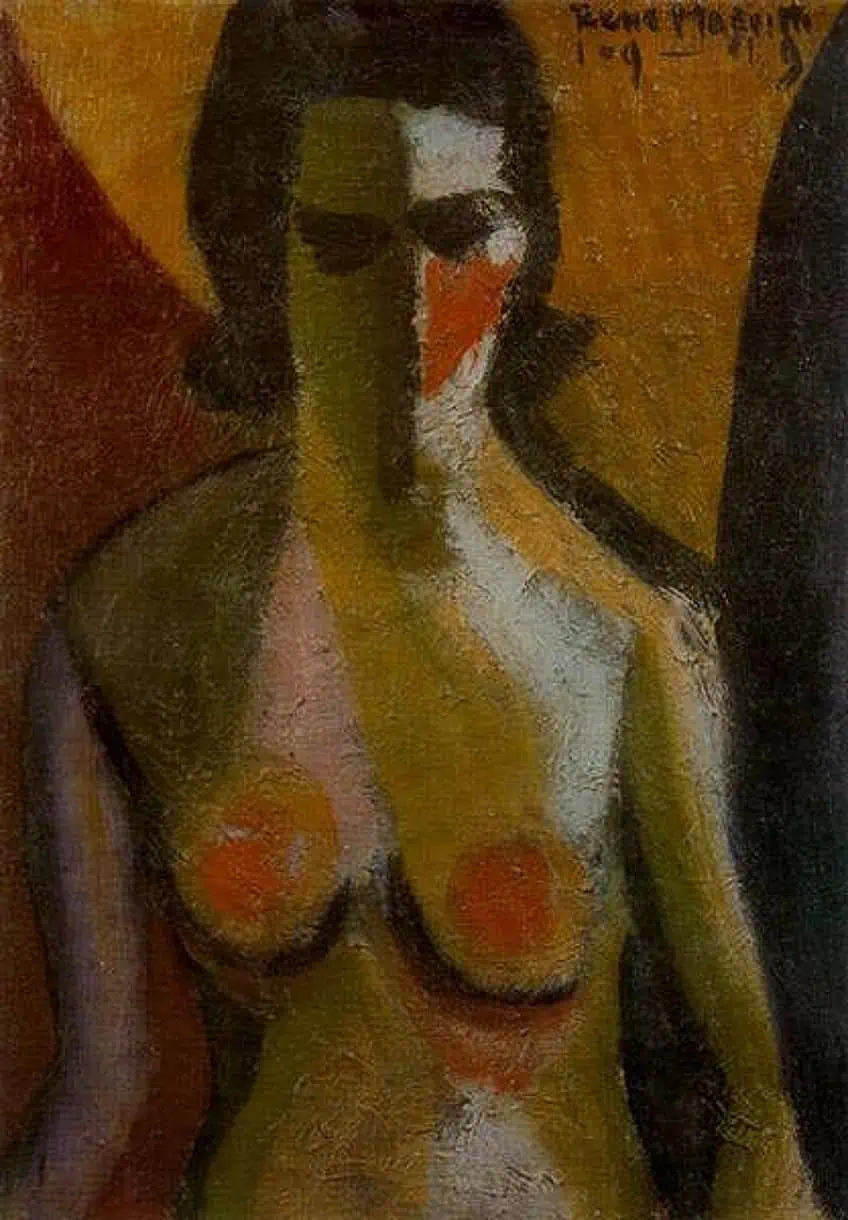
Magritte discarded the Impressionistic approach at the conclusion of the war, ushering in his “vache period”. These works of art were dark, angular, and provocative, in direct contrast to the joyful, vibrant artwork he painted before the war, and were strongly influenced by the Fauvists in their technique. His “vache period” had been so dubbed because, in French, vache means cow, meaning in this case, an extremely big lady or sluggish person. Magritte depicted this crudeness in his works, which, as he expected, were not widely embraced. Magritte returned to the surrealist style he experimented with before World War II in 1948. During this time, he had his biggest critical and financial success, with a series of retrospectives focusing on his oeuvre.
The Son of Man Meaning
In 1963, the famous Surrealist artist Magritte was asked to create a portrait of himself, and he started working on The Son of Man painting. However, Magritte found it rather challenging to create a self-portrait in the usual manner, therefore he decided to rather paint in the Surrealist style, as he felt that producing self-portraits was a “problem of conscience”. A gentleman stands in front of a coastal landscape in this famous apple painting.
While the sky above him is largely gray and cloudy, the subtle shadows that can be observed on the man’s left side suggest the presence of some sunlight.
Symbolism
The gentleman appears out of place in such a casual atmosphere, seemingly overdressed in a smart bowler hat and large overcoat – the bowler hat appears regularly in René Magritte’s art and potentially hints at his political affiliation with the Communist party. As mentioned before, his left arm bends the wrong way at the elbow. Yet, the elbow is not the strangest feature of the artwork; the most distinctive element is the massive green apple that mostly conceals the gentleman’s face.
The apple floats right in front of his face, seemingly defying the laws of gravity and encouraging viewers to wonder what the man’s face really looks like, allowing them to reach their own conclusions.
According to René Magritte, the artwork simply depicts mankind. He contends that what we see conceals something else, but we still desire to see what is concealed by what we perceive. There is always some curiosity about what is concealed and what the visible world does not reveal. This creates a tension between the viewable world that is apparent and the viewable world that is concealed.
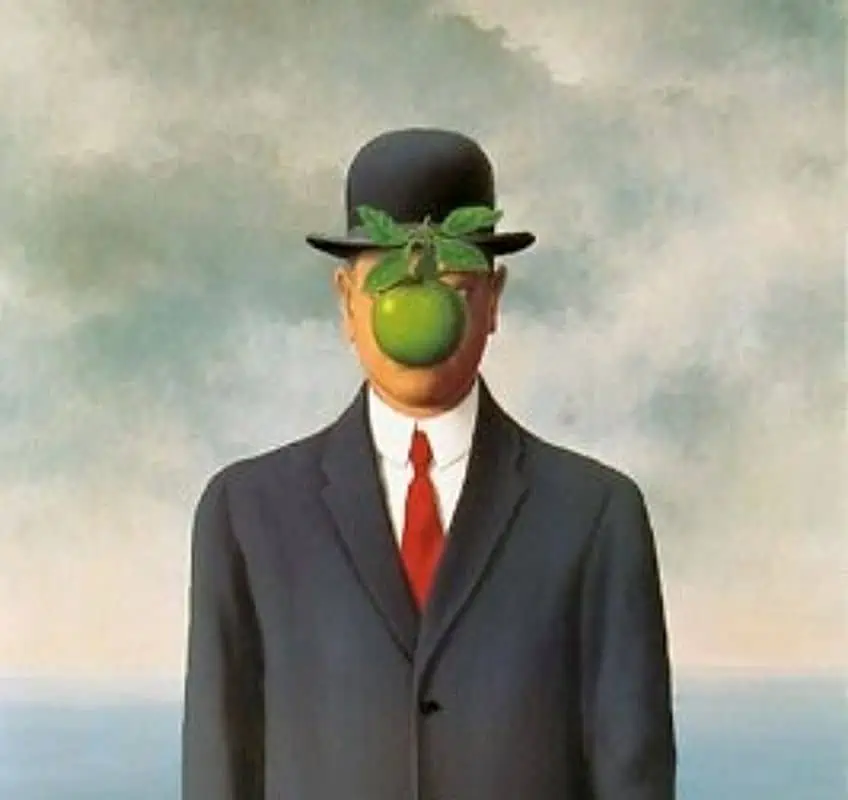
The gentleman’s covered face reflects the hidden parts of human identity. Magritte addresses how much of our genuine selves we disclose to the world and the masks we use to hide our feelings and innermost thoughts by concealing his face behind the apple. The gentleman in the artwork wears a black suit, which is typically associated with business clothing and the social conventions of society. It, therefore, signifies adherence to societal standards and expectations. In a society where individuals often want to fit in and be accepted, the suit may represent the desire for conformity and the loss of individuality.
Another prominent feature in this famous Surrealism artwork is the bowler hat. Like the business suit, the hat symbolizes uniformity and the repression of individuality. Bowler hats were fashionable at the beginning of the 20th century, and they were typically associated with a middle-class conservative mindset. The conflict between originality and conformity is a common topic in René Magritte’s artwork. He regularly challenged cultural norms, pushing audiences to consider how much they adhere to societal standards and the influence it has on their unique identities.
In his artworks, René Magritte regularly examined the contradictory nature of perception and the interaction between illusion and reality.
He sought to challenge our assumptions of what we should perceive and comprehend by contrasting the face and the apple. The appearance of the apple highlights issues regarding perception’s limitations and the challenging nature of human understanding. He subverts the viewer’s preconceived notions and generates a feeling of mystery and intrigue by positioning the apple in such an unusual location, hiding some of the face rather than entirely covering it. The cloudy sky contributes to the famous apple painting’s ambiguity. They fail to provide a clear narrative, allowing much room for personal interpretation.
Religious Connotations
“The Son of Man” is a term with obvious theological connotations, notably in relation to the representation of Jesus Christ. Some scholars have interpreted this famous apple painting in a religious context, noticing analogies between the painting’s shrouded face and the notion of the holy or sacred. The term “The Son of Man” may allude to Christ’s relationship with mankind and the enigmatic nature of human existence. However, the famous Surrealism artist did not personally provide any obvious biblical interpretations of his paintings.
His intention was typically to elicit contemplation and encourage viewers to come up with their own unique views on the work. The apple has significant theological significance, especially in relation to the account of Adam and Eve and the Garden of Eden. In that Biblical account, the apple signifies temptation, knowledge, and humanity’s fall as a result of defiance and sin. Some believe that Magritte addresses these topics and raises issues about temptation, human curiosity, and the repercussions of pursuing knowledge by including the apple.
Comparison to Other Works by Magritte
Some of the motifs seen in The Son of Man painting are also evident in many other works by René Magritte. The suit and bowler hat are, for instance, featured in many of his other famous works. The bowler hat is featured in works such as Golconda (1953) and The Spirit of Adventure (1962). He also used apples in works such as The Listening Room (1952), and The Postcard (1960). It’s also reminiscent of The Great War on Facades (1964). If one takes a look at this second artwork, one will observe that it similarly depicts a person positioned in front of a wall with a view of the sea.
In this painting, however, a woman is portrayed clutching an umbrella, and a flower is covering her face instead of an apple.

Magritte is a fan of surrealist art, as seen in his other artwork, Man in the Bowler Hat (1964). In this case, a bird obscures the man’s face. However, the work that most resembles The Son of Man painting is The Taste of the Invisible (1964). This painting features the same gentleman in a black overcoat, white shirt, red tie, and black bowler hat. Also present is the large green apple, however, this time it completely covers his face, even the eyes. The background of this painting, though, is not as visually interesting as the previous one, with a background comprising vertical streaks of brown. This work is not as well-known as the famous Surrealism artwork, The Son of Man, though.
Legacy of The Son of Man by René Magritte
The Son of Man by René Magritte is among the Surrealism movement’s most well-known works, possibly because of its countless appearances in mainstream culture, where it has been satirized by everyone from The Simpsons to Norman Rockwell. Rockwell employed Magritte’s apple motif in his work of art Mr. Apple in 1970, but the entire head of the subject is replaced with a large red apple instead of being concealed. When Rockwell’s artwork was auctioned off in 2011, his letters detailing its production were also included.

The letters were addressed to Mr. Blum, and in one of them, Rockwell recounts how he was keeping the apples fresh in his fridge and was excited about creating such a unique artwork. When it was complete. He sent another letter to Mr. Blum, telling him to be careful, as the paint was still fresh, instructing him to wait a few months before varnishing it. Magritte’s apple theme additionally inspired Paul McCartney when he named his record label Apple Records, which led to Steve Jobs naming the company he founded Apple Computers.
Magritte’s famous apple painting also briefly appeared in the gallery scene from the music video for Scream by Michael Jackson.
The Son of Man by René Magritte is also prominently featured in the remake of the movie Thomas Crown Affair (199). It is prominently displayed at the protagonist’s home in the movie. The love interest describes the person in the painting as the typical faceless businessman. To mislead the cops, the protagonist employs a large number of accomplices who are costumed as the subject of the artwork. He does this when entering the museum to bring back the work of art that he stole earlier in the movie. All of the conspirators are carrying briefcases stuffed with copies of The Son of Man painting.
This famous Surrealism artwork appears again in Days of Summer (2009), and Stranger than Fiction (2006). After reading this article, you may be keen to see it in person. However, this is unfortunately not possible as it is part of a private collection. The famous was last seen hanging in LHotel’s bar in Montreal’s old historic district in October 2011. Because it is privately owned, the chances of seeing it in person are very low, although copies of the original are available to buy as prints online.
René Magritte, the Belgian painter, was known for his humor and whimsy, yet none of his paintings caught the world’s imagination with such enthusiasm as The Son of Man painting. René Magritte’s advisor and friend, Harry Torczyner, commissioned the artist to create a self-portrait a year before the composition was produced. René Magritte found this job rather difficult, so he concealed his face with a symbolic piece of fruit as a compromise. It depicts a gentleman in a bowler hat and business suit standing behind a large green apple. While the intriguing canvas remains in a private collection, limited edition copies of the artwork have been created through a partnership with the Magritte Foundation, allowing collectors to own this famous Surrealism artwork.
Frequently Asked Questions
Who Is the Son of Man in the Painting by Magritte?
Even though the man’s face is concealed, we know who it was meant to portray as it was originally commissioned to be a self-portrait of the artist himself. However, René Magritte did not like the idea of producing a painting of his own face and decided to hide his facial features behind a big green apple. So, why did he decide to call it The Son of Man, then? Due to this title, as well as the inclusion of the apple (a significant symbol in the Biblical text), many people believe that the artwork has religious connotations. However, the artist himself never expressed anything like that and preferred to keep the actual meaning of the painting open to personal interpretations.
Who Painted The Son of Man Painting?
This famous Surrealism artwork was produced by René Magritte, an artist originally from Belgium. René Magritte, born in Lessines, Belgium, on the 21st of November, 1898, is widely considered to be one of the most significant individuals in 20th-century art. He is well-known for his provocative and dreamy imagery that pushes the boundaries between realism and illusion. René Magritte’s famous Surrealism artworks often depicted everyday things in unusual settings, creating a feeling of intrigue and mystery. The Son of Man painting is one of his most renowned and recognizable works, displaying his distinct original style and symbolic exploration. Magritte died on the 15th of August, 1967, leaving behind an incredible artistic legacy.
Jordan Anthony is a Cape Town-based film photographer, curator, and arts writer. She holds a Bachelor of Art in Fine Arts from the University of the Witwatersrand, Johannesburg, where she explored themes like healing, identity, dreams, and intuitive creation in her Contemporary art practice. Jordan has collaborated with various local art institutions, including the KZNSA Gallery in Durban, the Turbine Art Fair, and the Wits Art Museum. Her photography focuses on abstract color manipulations, portraiture, candid shots, and urban landscapes. She’s intrigued by philosophy, memory, and esotericism, drawing inspiration from Surrealism, Fluxus, and ancient civilizations, as well as childhood influences and found objects. Jordan is working for artfilemagazine since 2022 and writes blog posts about art history and photography.
Learn more about Jordan Anthony and about us.
Cite this Article
Jordan, Anthony, ““The Son of Man” by René Magritte – A Detailed Analysis.” artfilemagazine – Your Online Art Source. August 8, 2023. URL: https://artfilemagazine.com/the-son-of-man-by-rene-magritte/
Anthony, J. (2023, 8 August). “The Son of Man” by René Magritte – A Detailed Analysis. artfilemagazine – Your Online Art Source. https://artfilemagazine.com/the-son-of-man-by-rene-magritte/
Anthony, Jordan. ““The Son of Man” by René Magritte – A Detailed Analysis.” artfilemagazine – Your Online Art Source, August 8, 2023. https://artfilemagazine.com/the-son-of-man-by-rene-magritte/.


